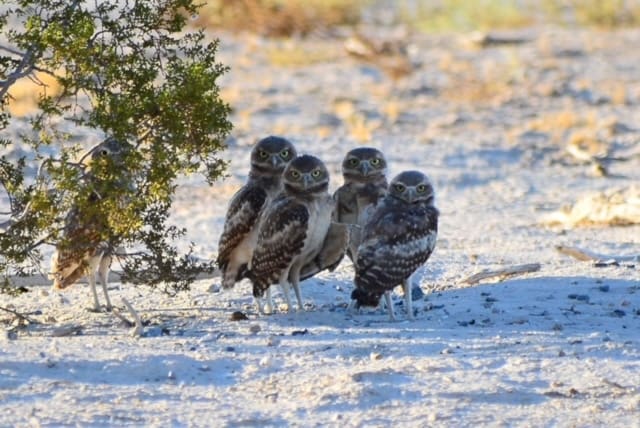The Burrowing Owl

WHAT STERN-LOOKING WETLANDS PARK BIRD SPENDS A LOT OF TIME BELOW “TERRA FIRMA”?
Despite its ever-constant, intimidating stare—the result of bearing a bold, white unibrow over its penetrating yellow eyes—the burrowing owl (Athene cunicularia) is a treat to watch as it performs most of its daily activities mostly on solid, open ground. In the western US, said owl has become part of a new subspecies, the western burrowing owl (Athene cunicularia hypugaea). It’s listed as endangered in Minnesota, threatened in Colorado, and is a species of concern in California, Montana, Oklahoma, Oregon, Utah, Washington and Wyoming. While the great “open spaces” found in most of Nevada are ideal for the burrowing owl, the seemingly ever-growing urbanization of the Las Vegas Valley is sadly reducing the owl’s opportunities to find suitable habitat.
Despite this, the open desert scrub areas of Clark County Wetlands Park are ideal habitat for the owls. They thrive in burrows dug by other animals in treeless spaces. They often choose burrows that have a lot of other burrows nearby for potential areas to escape to, including burrows with short perches nearby, so they can keep an eye out for predators like birds of prey, coyotes, foxes, badgers, bobcats, and skunks. The former burrows of mammals, such as ground squirrels, badgers, skunks, and tortoises are a good fit. When an owl takes over a burrow, it will modify it to its preference using its beak to dig and its feet to kick the loose dirt out. In a pinch, the owls may use metal culverts and pipes in the ground as burrows. Burrowing owls have a higher tolerance for carbon dioxide than other birds as they spend a lot of time underground with little ventilation.
Burrowing owls are small, just slightly larger than an American robin. Typically, adults are up to 10″ long, have a 20-24″ wingspan, and weigh under 8 oz. Males tend to be longer and females tend to be heavier. In addition to their bright yellow eyes, they have yellowish to greenish beaks. Their faces are flat, with their prominent white eyebrows, a white chin, and ears lacking tufts. Their legs are gray and longer than other owls’. Adults have a brown upper body with white spotting and a white chest and lower body with brown spotting or barring. Juveniles are similar but lack many of the white spots on the upper body and brown spots on the lower body.
Unlike other owls, burrowing owls can be active day and night. They are, however, mainly crepuscular (favoring dawn and dusk hunting trips). During the day, the owls hunt more insects and at night, more mammals. For this, they will either perch up high and then silently swoop down on prey or physically chase prey across land. Their diet is variable and includes large insects, small rodents, and lizards. Also unique from other owl species, burrowing owls will eat seeds and fruits, such as prickly pear.
Breeding season for the owl is late March to April. A male will woo its mate with a “who-who” call to his burrow, and the birds will customize the space together. The female will lay four to 12 eggs (averaging nine) to comprise her clutch over a couple of days and will incubate the clutch for about a month. The parent owls will jointly participate in raising their young. The young will begin to fledge a month after birth.
Burrowing owls can be quite vocal. They also use the “who-who” call when defending their territory. Other sounds include clucks, clattering, screams, and a rattlesnake-like hiss from juveniles. These calls are usually accompanied with the bobbing of their head, which they tend to do when excited or agitated. Because of this, early cowboys and ranchers called the owls “howdy birds”.
Seeing a group of four or five juvenile burrowing owls fledging is nothing short of entertaining! Keep your eyes peeled on the “dry side” of the Park in late May or June!
-By Constance Carlson; photo posted by an anonymous Facebook user
Please enjoy these YouTube videos:
The Very Strange and Unusual Burrowing Owl
Burrowing Owl Call
Outdoor Nevada S1 Ep20 Clip | Burrowing Owls
Future of burrowing owl preserve in Northwest Valley neighborhood unclear
